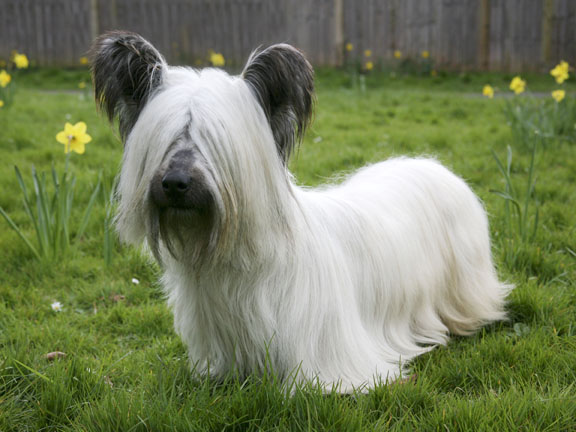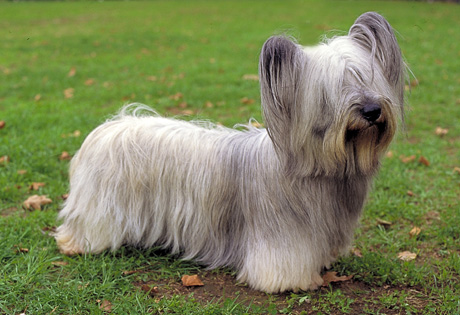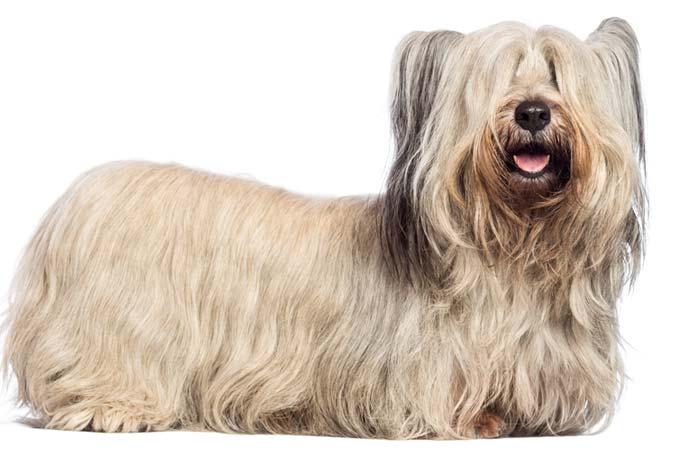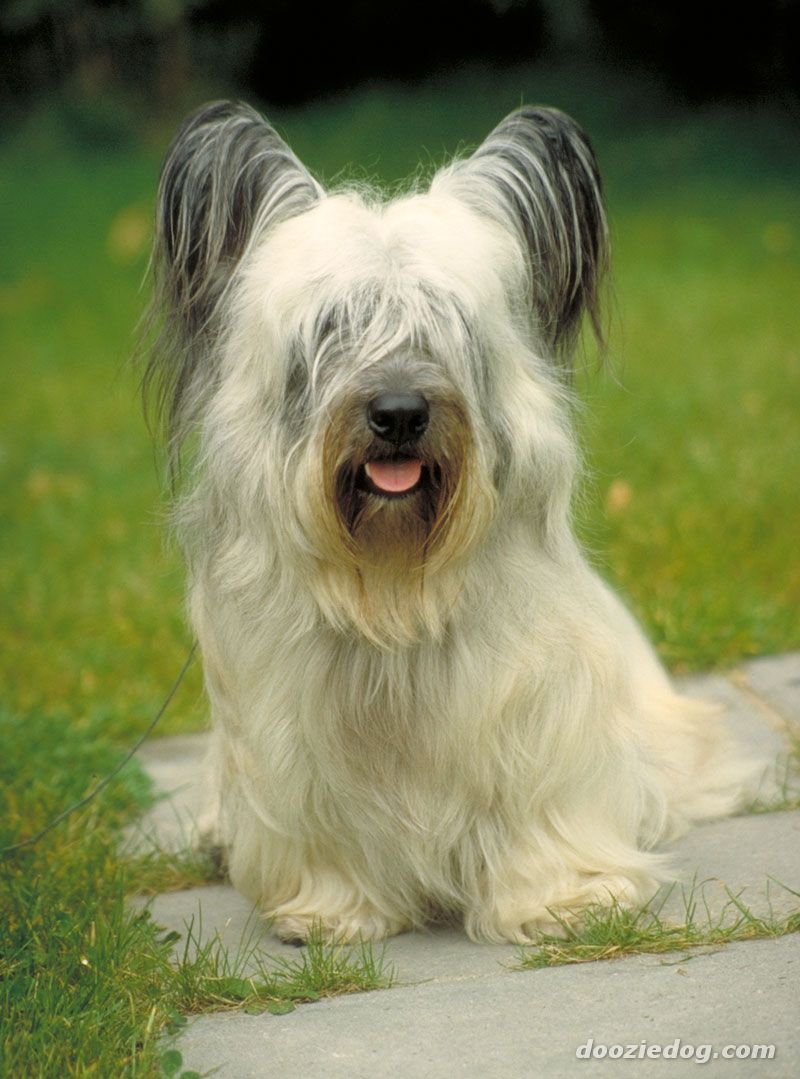
The Breed History
Sky Terriers are considered to be one of the most ancient of terriers.
This type can be traced back to records dating four centuries ago
in the Isle of Skye in the Hebrides region of Scotland. Popular with
English Royalty in the 1600s, they remain popular today in the
British Isles. The AKC first registered this breed in 1887. The breed
reputation for loyalty was advanced by the story of Bobby, a Skye
terrier who was featured in Disney's story of "Greyfriar's Bobby".
Breeding for Function
Agility, strength, versatility and a tenacious pursuit of vermin,
badgers, otter and foxes were bred into them. These dogs are adept
at going to ground, and display unusual courage and agility.
Physical Characteristics
Height at Withers: female 9.5" (24 cm), male 10" (25.5 cm)
Weight: 19-23 lb (8.5-10.5 kg)
Coat: The double haircoat consists of a short soft wooly undercoat
and a hard long straight outer coat. Coat length is about 5 1/2".
They are normally groomed with a part that extends along the
topline from head to tail. The hair cover on the head historically
served to protect against thorns and foe since the hair normally
covers the eyes. The coat is essentially one color, and options
include black, fawn, cream, silver platinum, blue, or varying shades
of gray. Points may be dark to black, and a small (< 2") white
marking on the chest is tolerated. Until the mature coat finalizes
at 1 1/2 years, the color may vary from the standard and is not
penalized in show.
Longevity: 13-15 years.
Points of Conformation: Skye Terriers are twice as long as high,
and a long flowing silky coat that hangs to the ground is a key
breed characteristic. Well boned and muscled, they are sturdy and
possess high head carriage. They have medium-sized eyes which are
usually darkly colored, close set and have a very bright expression.
The head is long, ears are feathered and either carried pricked up
or dropped depending on the type. The drop ear breed variety has
larger low set pendulous ears that hang against the head. The
stop is slight, the muzzle strong and it tapers slightly. The nose is
black. Other nose colors disqualify the dog. The neck is arched and
moderate in length. The topline is level. The thorax is fairly deep
and oval in cross section. A well-feathered tail is carried below the
topline and is long and slightly curved. The limbs described in the
standard can have a slight curvature, and are notably short. Feet are
hare in shape, nails short and strong and preferred black in color.
The gait is long, low, fast and smooth.
Recognized Behavior Issues and Traits
Descriptors of the breed include: Exceptionally loyal, intelligent,
independent streak, friendly with family, though they can be snappy
especially with children.
They are aloof with strangers, and may fight with other dogs. They
have medium grooming needs. These are high activity, high barking
dogs, and good for country or city living (even apartments). They
can be one-man dogs. Early socialization to people, pets and places
is important. Early obedience training is also recommended. They
like to dig, especially if bored.
Normal Physiologic Variations
None Reported
Drug Sensitivities
There are reports of Skye Terriers having serious, and sometimes
fatal reactions to high doses of ivermectin (not the low dose found
in heartworm preventatives). The Skye Terrier Foundation (see
below) is offering free testing for the recently discovered MDR1
(ivermectin/drug toxicity) mutation to see if it exists in the breed.
The mutation was not found in 5 Skye Terriers tested by the original
researchers.
Inherited Diseases
Patella Luxation: Polygenically inherited laxity of patellar
ligaments, causing luxation, lameness, and later degenerative joint
disease. Treat surgically if causing clinical signs. Reported at a high
frequency by OFA, but too few Skye Terriers have been screened to
determine an accurate frequency.
Hip Dysplasia: Polygenic trait causing degenerative joint disease
and hip arthritis. Too few Skye Terriers have been screened by OFA
to determine an accurate frequency.
Elbow Dysplasia: Polygenic trait causing elbow arthritis. Too few
Skye Terriers have been screened by OFA to determine an accurate
frequency.
Disease Predispositions
Hypothyroidism: Inherited autoimmune thyroiditis. 16.99% of Skye
Terriers test positive for thyroid autoantibodies, with a 3.04x odds
ratio versus other breeds. (Average for all breeds in this study was
6.40%).
Copper Toxicosis (Copper Hepatopathy): Signs include anorexia,
depression, and jaundice. Can lead to chronic hepatitis, cirrhosis,
and acquired portosystemic shunt. Treat with copper chelating
agents and liver support medications. The disease can be diagnosed
by a liver biopsy. Thought to be caused by a disorder of intracellular
bile metabolism. Unknown mode of inheritance.
Ectopic Ureters: Skye Terriers are an over-represented breed
for ectopic ureters. Clinical signs are urinary incontinence and
dribbling. Affected dogs can also have hydro-ureter, hydronephrosis,
pyelonephritis, bladder hypoplasia or congenital incompetence of
the urethral sphincter. Most affected dogs are female. Unknown
mode of inheritance.
Ocular Disorders: Too few Skye Terriers have been CERF examined
to determine accurate frequencies for inherited ocular disorders.
All Skye Terriers considered for breeding should have a CERF
examination.
Renal Dysplasia and Polycystic Kidney Disease are reported on the
Skye Terrier Club (UK) website.
Allergic inhalant dermatitis, Lens luxation, Oligodontia,
Tracheal collapse, and von Willebrand's Disease are reported.
Genetic Tests
Tests of Genotype: none
Tests of Phenotype: Recommend patella evaluation, hip and
elbow radiographs, CERF eye examination, thyroid profile including
autoantibodies, cardiac examination, and kidney ultrasound.
Miscellaneous
- Breed name synonyms: Skye
- Registries: AKC, UKC, CKC, KCGB (Kennel Club of Great Britain),
ANKC (Australian National Kennel Club), NKC (National Kennel Club)
- AKC rank (year 2008): 143 (88 dogs registered)
- Internet resources: The Skye Terrier Club of America:
http://clubs.akc.org/skye/
Skye Canada: www.skyecanada.ca
The Skye Terrier Club (UK): www.skyeterrierclub.org.uk
The Skye Terrier Foundation: www.skyeterrier.org
Photo Gallery of Breed - Skye Terrier - Dog Breed








 Animalia Life
Animalia Life